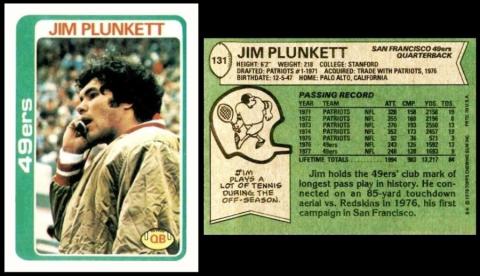
I kind of liked the thought that this player was just rousing from his sleeping bag, and looking quite tired after a night of revelry, so he got the nod - and also he was playing, at the time of this card, for the San Francisco 49ers,that being the town of our event, at the start, anyway.
Of course this is American Football, but it is still football of a sort, and it is also an American event we celebrate with the theme of the week for this week.
You may not have heard of our man is James William Plunkett Jr., but, according to the Trading Card Database, there are almost fourteen hundred cards bearing his image. They start with him as part of the New England Patriots, in 1971, and, at time of typing this, he has just been featured as card 18 of the Leaf Pearl - Lettermen set, issued in 2025.
He was born on December the 5th, 1947, in San Jose, California, and he was a quarterback, today the most valuable, and highly paid player. They also control most of the game, throwing most, if not all, of the forward passes, and planning, as it goes along, the way the game will go. In fact, the position was formerly known as a Field General before it was changed to Quarterback.
If you want to read more, nip along to the California Museum, which you can do online. That tells you that he was born "to parents of Native American and Hispanic origin", but not that he was the only Latino to so far be named as the most valuable player in a Super Bowl Game.
I have been able to call this set trade because it was - you could still go in a store and buy these cards in a wax pack, with one stick of bubble gum, or rather you could buy the gum and the cards would be the free gift. I am seriously not sure that anyone thought that way, even if thinking so was more legal.
However it is also known that you could also buy these cards, without the gum, in supermarkets, in a clear plastic wrapper that looked like a long strip. The packets cost thirty cents - whilst the strip was fifty-nine cents. I am waiting to hear whether there were more cards in the strip than the packet, or even how many were in each.
